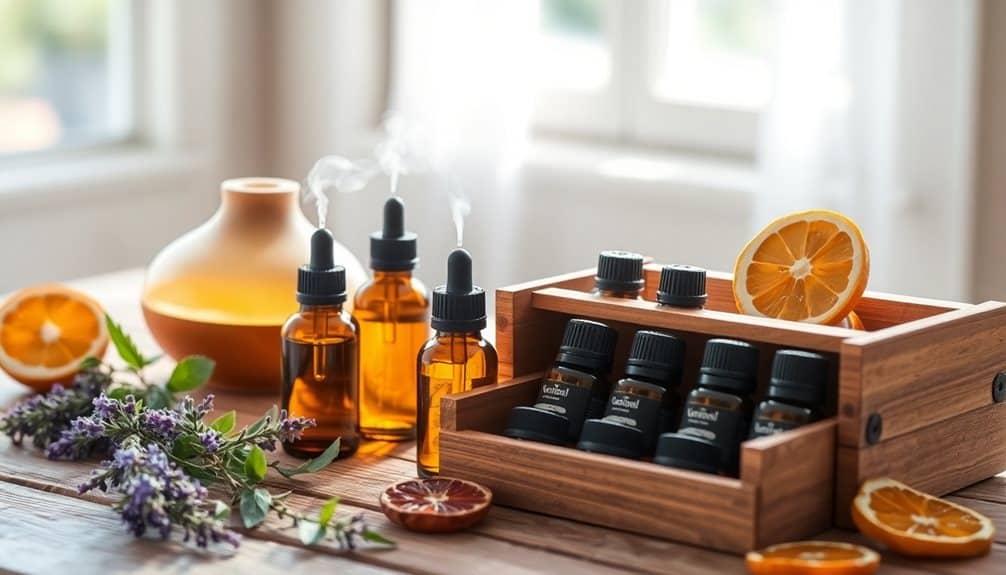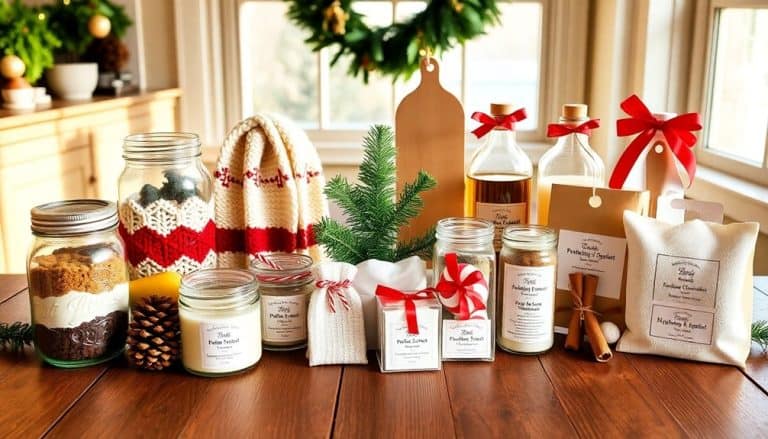This website contains affiliate links. Some products are gifted by the brand to test. As an Amazon Associate, I earn from qualifying purchases. The content on this website was created with the help of AI.
To start blending essential oils safely, you'll need to understand the basic categories: relaxants (like lavender), stimulants (like peppermint), antiseptics (like tea tree), and emotional balancers (like bergamot). Always follow proper dilution ratios of 1-3% for topical use, and limit your blends to 2-4 oils maximum. You'll need amber or cobalt glass bottles, measuring tools, and carrier oils for dilution. Start with simple combinations like lavender and bergamot for relaxation, or peppermint and lemon for energy. Remember to patch test new blends and store oils properly in cool, dark places. The world of therapeutic aromatherapy opens up with proper technique and safety knowledge.
Key Takeaways
- Start with 2-3 essential oils in your blends and follow proper dilution ratios of 1-3% for safe topical application.
- Choose oils from different categories like relaxants (lavender), stimulants (peppermint), or emotional balancers (bergamot) for targeted benefits.
- Always perform a patch test before using new blends and store oils in dark glass bottles away from light and heat.
- Document your blending process, including measurements and effectiveness, to track successful combinations and learn from mistakes.
- Begin with proven combinations like lavender-bergamot for relaxation or peppermint-lemon for energy, following recommended ratios.
Understanding Essential Oil Categories
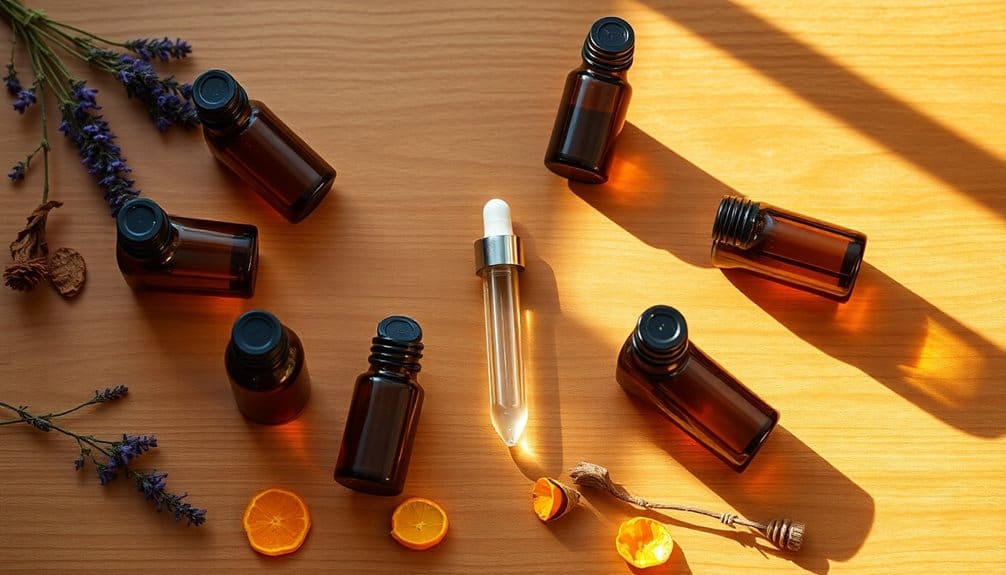
Essential oils fall into several distinct therapeutic categories that determine their primary uses and effects. You'll need to understand these categories to create effective aromatherapy blends safely. The main categories include relaxants (like lavender and chamomile), stimulants (such as peppermint and rosemary), antiseptics (tea tree and eucalyptus), and emotionally balancing oils (ylang ylang and bergamot).
Each category serves specific therapeutic purposes. Relaxants help reduce stress and promote sleep, while stimulants enhance mental clarity and energy. Antiseptic oils support immune function and cleansing, and emotional balancers help stabilize mood and promote well-being. You'll find that some oils fit into multiple categories, making them versatile choices for your blending toolkit.
When working with these categories, it's vital to respect proper dilution ratios and safety guidelines. Don't exceed recommended usage amounts, and always verify if an oil is safe for your specific situation. Keep in mind that some oils aren't suitable for children, pregnant women, or people with certain medical conditions. Start with single-category blends before experimenting with cross-category combinations.
Safety First

Now that you're familiar with oil categories, proper safety protocols must guide every aspect of your aromatherapy practice. Essential oils are highly concentrated plant compounds that require careful handling and respect for their potency. Never apply undiluted oils directly to your skin, and always perform a patch test before using a new oil.
You'll need to dilute essential oils in a carrier oil before topical application. The general dilution ratio is 2% for adults (12 drops per ounce of carrier oil) and 1% for children over age 2 (6 drops per ounce). Don't use essential oils on infants under 3 months old, and consult a healthcare provider if you're pregnant, nursing, or have medical conditions.
Store your oils in dark glass bottles away from direct sunlight and heat. Keep them out of children's reach and clearly label all blends with ingredients and dates. Don't ingest essential oils unless under professional guidance, and avoid contact with eyes and mucous membranes. If irritation occurs, don't rinse with water – instead, apply carrier oil to dilute the essential oil and seek medical attention if needed.
Basic Blending Principles

Successfully blending essential oils requires understanding their aromatic profiles and therapeutic properties. When creating your blends, always start with a carrier oil as your base and follow the recommended dilution ratios. Most essential oil blends work best with a 1-2% dilution for adults, which means using 6-12 drops of essential oil per ounce of carrier oil.
Your blending strategy should focus on creating balanced combinations that achieve your desired therapeutic outcome. Start with these fundamental principles:
- Top notes (like citrus oils) evaporate quickly and provide initial impact
- Middle notes (like floral oils) emerge after top notes and provide body to the blend
- Base notes (like woody oils) evaporate slowly and act as fixatives
- Never exceed 3-5 different oils in your initial blends
Begin with one oil from each note category and carefully document your formulations. It's critical to test small amounts first before making larger quantities. Remember that strong oils like peppermint or eucalyptus can easily overpower subtler oils, so use them sparingly. You'll develop a better sense of complementary combinations as you gain experience with different oil characteristics.
Essential Tools and Supplies
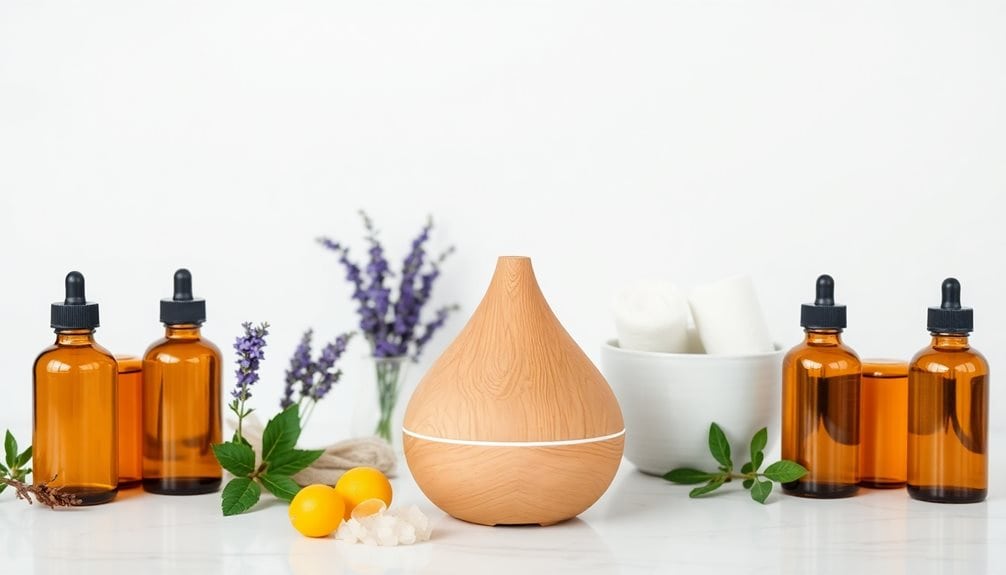
A well-equipped aromatherapy workspace requires specific tools and supplies to guarantee safe, precise blending and storage of your essential oil formulations. You'll need amber or cobalt glass bottles in various sizes (5ml to 30ml) to protect your oils from light degradation, along with glass droppers and orifice reducers for accurate dispensing. Don't forget to include measuring tools like graduated cylinders and pipettes for precise ratios.
Essential items include small glass mixing bowls, stainless steel mixing rods, and clean funnels dedicated solely to aromatherapy use. You'll also need bottle labels, a permanent marker, and a notebook to record your formulations. Store your supplies in a cool, dark cabinet alongside your carrier oils and essential oils.
Safety equipment is non-negotiable: nitrile gloves to protect your skin, safety glasses for eye protection, and clean cotton cloths for spills. Include a proper storage system with organizational dividers to keep oils separated by category. Finally, invest in airtight containers for bulk carrier oils and a small digital scale that measures in drops and milliliters for the most precise blending results.
Choosing Your Base Oils
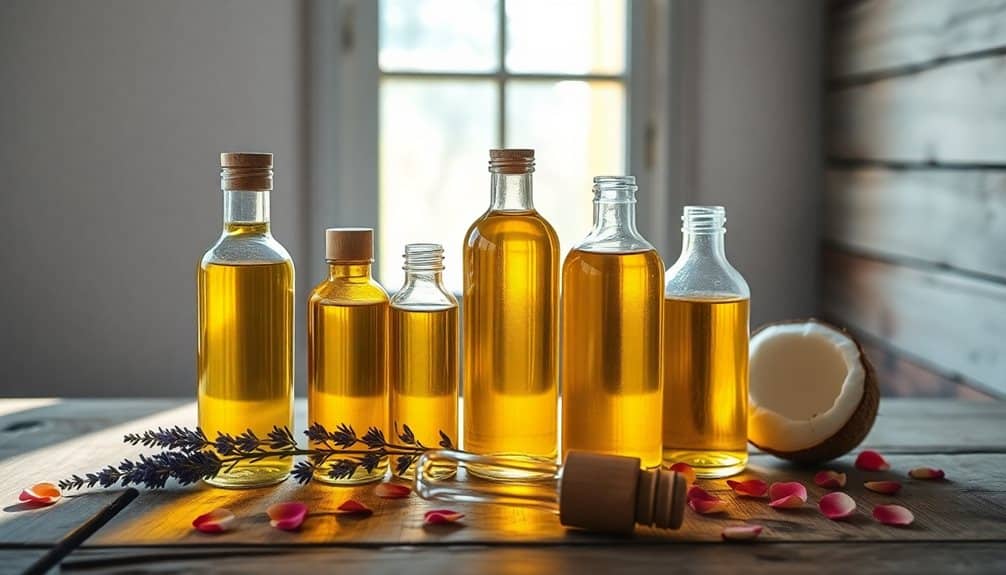
Base oils serve as the foundation of all aromatherapy blends, requiring careful selection based on their unique properties and therapeutic benefits. When you're selecting your carrier oils, you'll need to take into account factors like absorption rate, shelf life, and skin sensitivity. Virgin coconut oil and jojoba oil are among the most versatile options, as they're suitable for most skin types and have natural preservative properties.
Here are the most popular base oils for aromatherapy blends:
- Sweet Almond Oil – Light texture, rich in vitamin E, ideal for all skin types
- Jojoba Oil – Similar to skin's natural oils, long shelf life, non-greasy
- Fractionated Coconut Oil – Stable, odorless, excellent absorption rate
- Grapeseed Oil – Light, non-comedogenic, suitable for oily skin
Always perform a patch test before using any new base oil, as sensitivities can occur. Store your oils in dark glass bottles away from direct sunlight and heat to maintain their therapeutic properties. It's essential to use high-quality, cold-pressed, or unrefined oils whenever possible, as these retain more of their natural healing properties and provide better results in your aromatherapy blends.
Mastering Drop Ratios
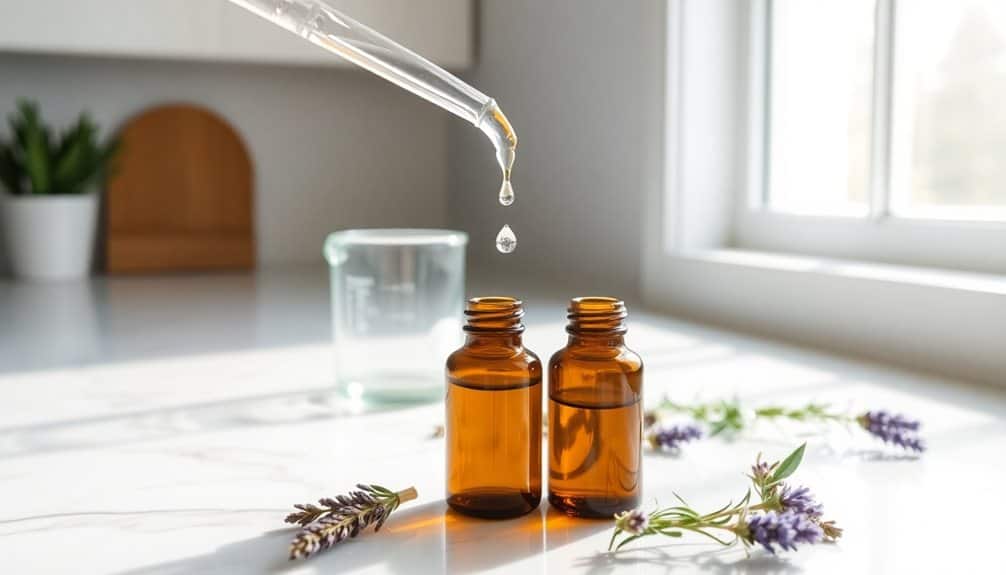
Understanding essential oil drop ratios forms the cornerstone of safe and effective aromatherapy practice. You'll need to master the standard dilution rates to avoid skin irritation and achieve ideal therapeutic benefits. For facial applications, maintain a 1% dilution ratio, which equals 6 drops of essential oil per ounce of carrier oil. Body applications can tolerate a 2-3% dilution, requiring 12-18 drops per ounce.
For acute conditions, you can temporarily increase the concentration to 5%, but don't exceed 30 drops per ounce. If you're working with particularly potent oils like cinnamon or oregano, cut these ratios in half. Children and elderly individuals require even lower concentrations, typically 0.5-1%.
When creating blends, you'll want to follow the 30-50-20 rule: 30% top notes, 50% middle notes, and 20% base notes. Keep track of your total drops, ensuring they don't exceed the maximum safe dilution for your intended use. Always document your formulations, including exact measurements and dates. If you're experiencing sensitivity, immediately reduce the concentration by adding more carrier oil.
Common Blending Mistakes

Making rookie blending mistakes can compromise both the safety and effectiveness of your aromatherapy treatments. When you're new to essential oil blending, it's essential to understand and avoid these common pitfalls that could render your blends ineffective or potentially harmful.
- Using oils that have oxidized or expired, which can cause skin irritation and reduce therapeutic benefits – always check dates and store oils properly in dark glass bottles
- Adding too many different oils to one blend, which can create conflicting therapeutic properties and overwhelm your senses – stick to 2-4 oils for beginners
- Failing to dilute essential oils properly in carrier oils, leading to skin sensitivity and adverse reactions – maintain proper dilution ratios of 1-3% for most applications
- Mixing oils without considering their therapeutic properties and chemical compositions – research each oil's properties before combining them
Remember to document your blending process, including exact measurements and observations about effectiveness. If you experience any adverse reactions, discontinue use immediately and consult a qualified aromatherapist. Start with simple combinations and gradually build your expertise as you become more familiar with each oil's characteristics.
Popular Scent Combinations

With a solid foundation in proper blending techniques, you'll want to explore well-established scent combinations that consistently deliver therapeutic benefits. For relaxation, combine lavender with bergamot and ylang-ylang in a 4:2:1 ratio. To boost energy, mix peppermint, lemon, and rosemary in equal parts.
For respiratory support, blend eucalyptus with tea tree and peppermint in a 3:2:1 ratio. If you're seeking stress relief, try a combination of frankincense, lavender, and sweet orange in a 2:2:1 ratio. For muscle tension, combine marjoram, peppermint, and Roman chamomile in equal proportions.
When creating sleep-promoting blends, mix lavender, vetiver, and cedarwood in a 3:2:1 ratio. For mental clarity, combine rosemary, basil, and lemon in a 2:2:1 ratio. You'll find that immune-supporting blends work well with tea tree, lemon, and eucalyptus in equal parts.
Always start with these tested combinations before experimenting with your own ratios. Remember to document your preferred blends and their effects, as individual responses can vary. Keep total drop counts within safe dilution ranges, typically 1-2% for topical applications.
Storage and Shelf Life
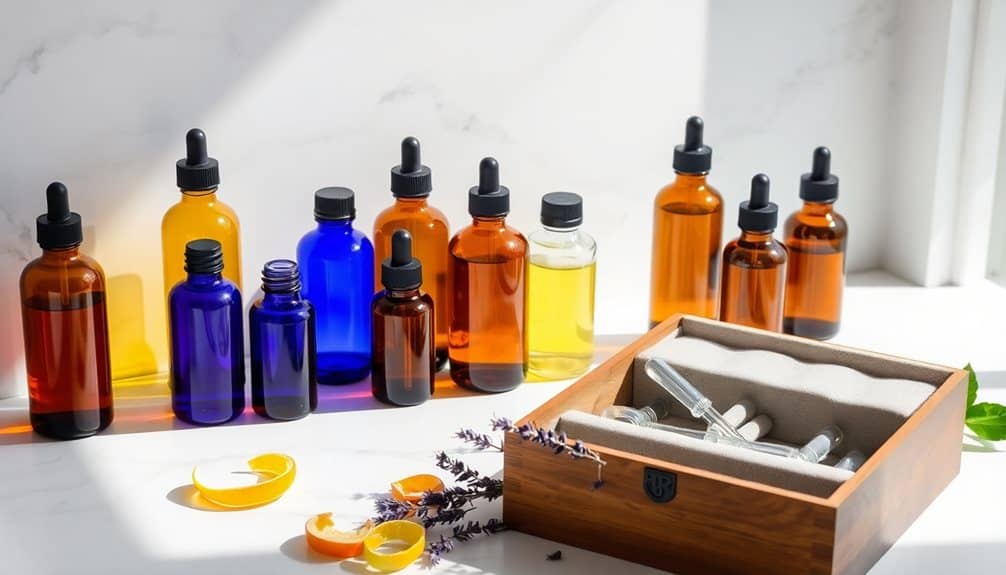
Proper storage of essential oils plays a critical role in maintaining their therapeutic properties and extending their usable life. Most essential oils will last 1-2 years when stored correctly, though citrus oils typically have shorter shelf lives of 6-12 months due to their higher oxidation rates.
To maximize your essential oils' longevity, you'll need to protect them from light, heat, and oxygen exposure. Store your oils in dark amber or cobalt blue glass bottles with tight-fitting caps, and keep them in a cool, dark place away from direct sunlight and heat sources.
- Always check the bottling date and maintain an inventory system to track expiration dates
- Keep oils away from children and pets in a locked cabinet or storage box
- Monitor for signs of oxidation: cloudy appearance, thickened consistency, or altered scent
- Store bottles upright and guarantee caps are tightly sealed after each use
If you notice any changes in color, consistency, or aroma, it's best to dispose of the oil. Some carrier oils may require refrigeration, so check specific storage requirements for each oil in your collection.
Using Your Custom Blends

Once you've created your personalized aromatherapy blends, it's essential to follow specific guidelines for safe and effective application. Always perform a patch test on a small area of skin before any topical use, and wait 24 hours to check for adverse reactions. For children and elderly individuals, dilute your blends at half the standard concentration.
When using your blends for massage, apply only to unbroken skin and avoid sensitive areas around the eyes, nose, and mouth. For diffusion, limit sessions to 30-60 minutes, and guarantee proper ventilation in the room. If you're using your blends in a bath, first mix them with a carrier oil or specialized bath dispersant to prevent oil droplets from floating on the water's surface.
Don't exceed recommended dosages – typically 2-3 drops of blend per 100ml of carrier oil for topical application, or 3-5 drops in a diffuser. If you're pregnant, nursing, or have medical conditions, consult your healthcare provider before using any essential oil blends. Store your custom blends in a cool, dark place and check them regularly for changes in color, consistency, or smell.
Frequently Asked Questions
Can I Ingest Essential Oil Blends I Make at Home?
You'd have to be a million times braver than me to ingest essential oils! Don't consume essential oils unless specifically directed by a qualified healthcare provider. They're highly concentrated substances that can be toxic, cause severe chemical burns, and damage your internal organs. Even food-grade oils aren't meant for consumption. Stick to external use only – diffusing, topical application with carrier oils, or aromatherapy methods.
Why Do Some People Get Headaches From Certain Essential Oils?
You might get headaches from essential oils due to several factors: sensitivity to specific compounds, allergic reactions, or using oils that are too concentrated. Strong scents can trigger the trigeminal nerve, which controls facial sensation and can cause head pain. Additionally, poor quality oils may contain synthetic additives or contaminants that can cause adverse reactions. If you're experiencing headaches, try diluting the oils more or switching to gentler alternatives.
How Do Essential Oils Compare to Synthetic Fragrance Oils?
Essential oils are natural plant extracts containing complex compounds and therapeutic properties, while synthetic fragrance oils are lab-created chemicals designed to mimic scents. You'll find essential oils are more expensive because they require significant plant material to produce. While synthetics may smell similar, they don't offer the same therapeutic benefits and can contain potentially harmful chemicals. You'll need to be especially careful with synthetic oils, as they're more likely to cause skin reactions and respiratory issues.
Will Essential Oil Blends Stain My Clothes or Furniture?
Essential oils can stain fabrics and damage furniture finishes, so you'll need to handle them with caution. Pure essential oils contain concentrated plant compounds that may leave oily marks or discolor materials. Dark-colored oils like patchouli or cinnamon are particularly likely to stain. Always dilute oils properly and avoid direct contact with fabrics. If spills occur, treat them immediately with rubbing alcohol or enzymatic cleaners.
Can I Use Essential Oil Blends if I'm Pregnant or Nursing?
When it comes to pregnancy and nursing, essential oils are like a double-edged sword – powerful enough to affect both you and your baby. You shouldn't use essential oils during your first trimester, and throughout pregnancy and nursing, you'll need to avoid specific oils completely. Always consult your healthcare provider before using any oils, and stick to pregnancy-safe options like lavender and chamomile at very diluted concentrations.

